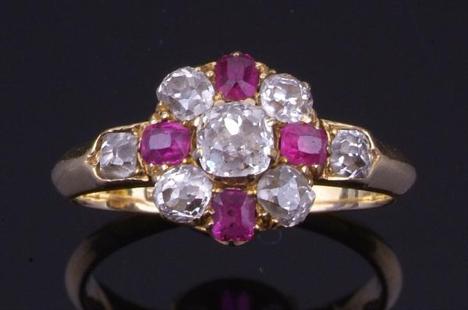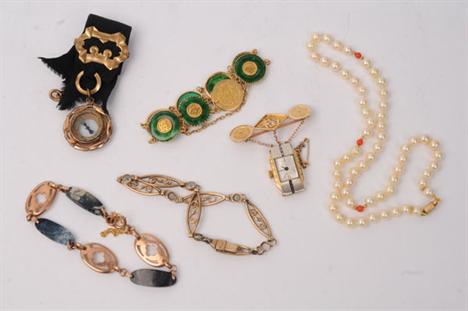36562 Preisdatenbank Los(e) gefunden, die Ihrer Suche entsprechen
36562 Lose gefunden, die zu Ihrer Suche passen. Abonnieren Sie die Preisdatenbank, um sofortigen Zugriff auf alle Dienstleistungen der Preisdatenbank zu haben.
Preisdatenbank abonnieren- Liste
- Galerie
-
36562 Los(e)/Seite
A Victorian ruby and diamond cluster ring, stamped `18`, the central old brilliant cut with a ruby at each of the compass points and an old cut brilliant between, with an old mine cut diamond to each shoulder, the diamonds totalling approximately 0.75 carats, finger size L . Visit www.dnfa.com for condition reports
BRASS CASED COMPASS BY TROUGHTON & SIMMS, LONDON, 19TH CENTURY raised on a socle foot, underside impressed `Drygas, Lyon`; together with a set of brass scales and weights; two early 19th century lead covered tobacco boxes; a copper miniature model of a ten gallon hat ; and a silver cigarette case (6)
A 19th century boxwood and brass mounted rule with inset compass, by W.Elliott & Sons, 56 Strand. London. Also stamped S.S. Rawlinson, the top inset a level, measuring 24 inches, in a fitted leather case with a hardwood and brass mounted by E Preston, with sliding covers over the glass tube. (2)
An Early XIX Century Brass Magnetic Sundial, Thomas Rubergall, 27 Coventry Street, London, the silvered dial with engraved compass rose, hinged gnomon and latitude arc, the brass casing engraved with measurements for London, Dublin, Paris, Moscow and four other cities, in a wooden case. *Webster`s records show that Thomas Rubergall worked at this address from 1805-1823.
`T Staight London`, an early Victorian turned ivory boxed thermometer and compass, the slightly domed circular screw off lid ornamentally turned, the base with compass mounted centrally to the inside of a three quarter ring mercury thermometer, the box 7.5cm (3in) diameterThomas Staight is recorded for ivory turning and barometers from 1829 -1866
A Collection of Four British Second World War Escape Compasses, including;. a) A "pill box` type escape compass with blackened card and red luminous dots, in its transparent soft plastic pod. b) A trouser fly button escape compass, in two parts with black finish as issued to the RAF. c) An early RAF blouse buckle escape compass, in two parts, the buckle of non-ferrous metal, the pivot of magnetized material d) A pair of shirt stud escape compasses of brass construction with concealed bare metal cards. Escape Compasses were issued to allied pilots, commandos, the regular army and SOE agents as part of escape and evasion kits. Many myths exist about their issue and use, there is also some conjecture as to the actual number of captured airmen and paratroopers who were able to escape from German stalags with the aid of these rudimentary magnetic north devices. It is also extremely doubtful that their German captors were not aware of such items, in fact the odds of making a "home run` out of Europe were very slight. Out of 10,000 RAF prisoners, only 30 succeeded in reaching Britain. Visit www.dnfa.com for condition reports
A Great War Group of Three to Second Lieutenant C. H. Sheppard, 1914-15 Star (RTS=4781 Pte. C.H. Sheppard. A.S.C.), British War and Victory Medals (2. Lieut. C. H. Sheppard.), fine. Princess Mary Christmas Tin, a Virnier`s Pattern British marching compass, No. 89476, dated 1917, together with a quantity of metal insignia, including a bi-metal 23rd London Armoured Car Company (Sharpshooters) cap badge, (lot). Visit www.dnfa.com for condition reports
A George III giltwood and gesso concert harp, Sebastian & Pierre Erard`s patent 5954, 18 Great Marlborough Street, London, fluted column with Gothic capital moulded with tracery, herald angels and saints, shaped base, scroll feet, 175cm high, c.1800 (distressed) Sebastian Erard was born in Strasbourg on 5th April 1752, and his name was originally spelled Erhard. He moved to Paris in 1768 and worked for an unknown harpsichord maker. Erard wanted to explore the fundamentals of instrument making, and it soon became apparent that he was a genius at finding ways around mechanical problems, a skill which came to the attention of the Abbe Roussier. His success as an instrument maker caused envy among his rivals who accused him of working outside the corporation without a licence. Louis XVI protected him and granted him a licence on his own authority. In 1777 Erard made his first square piano; it was probably a copy of an English Zumpe piano. A portrait of Erard was shown at the International Inventions Exhibition of 1885. Once his reputation was established, Erard persuaded his brother-in-law to join him in Paris. Their first pianos were squares with bichords throughout, and a five-octave compass. Erard made a combination of piano and organ with two keyboards for Marie Antoinette. The revolution of 1789 destroyed his business in Paris and in 1792 he opened a factory in Great Marlborough Street, London. Apparently he left his brother Jean-Baptiste to carry on the French branch. According to the London Post Office Directory, he opened an English branch as early as 1786, at 18 Great Marlborough Street, London. However, this may have been just for selling instruments at first. In 1902 they moved to 189 Regent Street, and then in 1904 to 158a New Bond Street, London. According to popular belief, Sebastian returned to Paris in 1796, leaving his nephew Pierre to carry on the London firm. This cannot be correct, however, as Pierre was not born until 1796. He died in 1855. Sebastian appears to have come back to London in 1801, as he took out a patent in England (number 2502) on 16th May 1801, for an improvement on the piano action. However, the bulk of this patent submission is taken up mainly with the harp. This represented some of the groundwork for his double-action harp. The harp seemed to be more important to him than the piano. If you look at most of the patent registrations from Sebastian, the harp comes first and the piano is just added on in the patent submission. There are exceptions to this in the cases when he took out patents for musical instruments only. On the covers of the submissions it says pianoforte and harp. Yet, when one reads the contents of any of these the harp is given preference over the piano. Perhaps this should not be so suprising, since Sebastian sold £25,000.00 worth of harps in the first year of the release of the new double-action harp. Finally, in June 1810, after eight years of working on it, Sebastian Erard patented the double-action harp with seven pedals (number 3332). This is regarded by most people as the date of the invention of the concert harp. The instrument had one pedal for each note. Each pedal had three positions or two notches, which raised the pitch of the note by a semitone for one notch, or a tone for both notches, by moving the top bridges to shorten the speaking length of the strings. This harp could be considered more versatile than the piano, since with the use of the pedals a player could get 21 pitches to the octave, while with the piano 12 was the limit. It is reported that Erard did not undress for three months before his harp was finished, snatching meals with pencil in hand and sleeping for an hour now and again. The concert harp of today basically maintains his design, as does the roller action for grands. He also had an eighth pedal for opening the back of the sound box, to work as a swell. At this time the harp was almost as popular in the home as the piano, and Erard made large numbers of both. He was also regarded as a master organ repairer.
Masonic Interest - a rare George V novelty snuff box, as a mason`s square, hinged cover engraved with a square and compass and motto `Aude Vide Tace`, inscribed `Wor. Bro. J Tyler I.P.M 1792/with Respects & Fraternal Regards/From Bro. W. Littler/P.P.G. Tyler Worcs., P.P.G.M.M./Tyler, Warwks., 1935, 6cm wide, Birmingham 1934
World War I & II Memorabilia inc. C19th French 1879 dated Bayonet & Scabbard, World War I British Army Bayonet & Scabbard, Scout`s Knife, Knife & Sheath, photographs of men in uniform, cap badges for Royal Artillery, Tank Corps, Intelligence Corps, Royal Warwickshire, Royal Berkshire, Sutton Valance School, Side Flashes, pair of Military Mess Medals, Sew-on Badges, Ration books, Driving Licence, Regimental Movement Orders, compass, lighters, belts, etc. (4 loose, 1 box & photos)
-
36562 Los(e)/Seite












